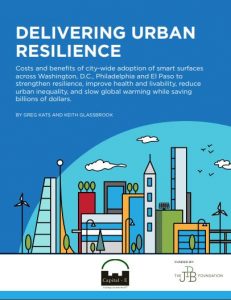
New Report Demonstrates How To Achieve Healthier, More Resilient Cities
Today, Delivering Urban Resilience, a new report authored by Capital-E, quantifies the range of costs and benefits for the adoption of citywide smart surface technologies in Washington, D.C., Philadelphia and El Paso.
“Cities are increasingly at risk from hurricanes and severe summer heat,” said lead author Greg Kats. “This report shows how citywide adoption of these smart surface technologies would save cities billions of dollars and cut greenhouse gasses while achieving transformative benefits like making cities cooler, more resilient, healthier and more equitable.”
The report documents that an investment in these technologies would result in net present values of $1.8 billion in Washington, D.C., $3.6 billion in Philadelphia and $540 million El Paso over a 40 year period. The work is built on more than two years of data collection and research in collaboration with 15 organizations, including U.S. Green Building Council, American Institute of Architects, the National League of Cities, the National Housing Trust, the Chesapeake Bay Foundation and The JPB Foundation.
“Delivering Urban Resilience is so critical because it is the first rigorous analysis of citywide surfacing options to manage sun and water at scale,” according to Mark Chambers, New York City’s Director of Sustainability.
Smart surface technologies include surfaces that help manage sunlight and rain, including solar PV roofs, cool roofs, green roofs, porous and high albedo pavements, trees or a combination of these features. This study demonstrates that these technologies can effectively address the severe cost of worse air quality, higher pollution and excess heat in urban low-income areas.
“The Delivering Urban Resilience report gives the green building movement the momentum needed to widen sustainable building perspectives past walls and into environments and the lives of the people who occupy them,” said Mahesh Ramanujam, president and CEO, USGBC. “Not only do the smart surface technologies in this report provide tangible cost benefits, but they promote the needed equity in quality of life for all city residents.”
This is the beginning of the Smart Surfaces revolution,” says former two-term Austin mayor, Will Wynn. “Delivering Urban Resilience provides an entirely convincing case that city-wide adoption of ‘smart surfaces’ like green and cool roofs and porous pavements are both cost-effective and essential to ensuring that our cities remain livable in a warming world.”
This report was launched at an event today with D.C. Mayor Muriel Bowser at Capitol Crossing, one of the largest developments in the Washington metro area, which is pursuing LEED Platinum certification.




